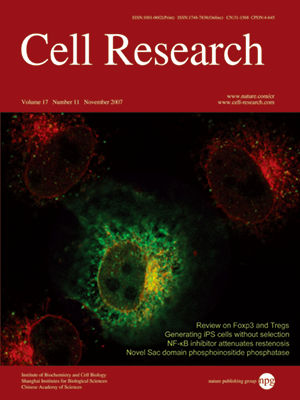
Volume 17, No 11, Nov 2007
ISSN: 1001-0602
EISSN: 1748-7838 2018
impact factor 17.848*
(Clarivate Analytics, 2019)
Volume 17 Issue 11, November 2007: 942-955
ORIGINAL ARTICLES
IL-4 protects the B-cell lymphoma cell line CH31 from anti-IgM-induced growth arrest and apoptosis: contribution of the PI-3 kinase/AKT pathway
Gregory B Carey1,2, Elena Semenova1, Xiulan Qi1 and Achsah D Keegan1,2
1Program in Oncology, Marlene and Stewart Greenebaum Cancer Center, University of Maryland School of Medicine, Baltimore, MD, USA;
2Department of Microbiology and Immunology, University of Maryland School of Medicine, Baltimore, MD, USA
Correspondence: Achsah D Keegan,(akeegan@som.umaryland.edu)
Interleukin-4 (IL-4) promotes lymphocyte survival and protects primary lymphomas from apoptosis. Previous studies reported differential requirements for the signal transducer and activator of transcription 6 (STAT6) and IRS2/phosphatidylinositol 3 kinase (PI-3K) signaling pathways in mediating the IL-4-induced protection from Fas-mediated apoptosis. In this study, we characterized IL-4-activated signals that suppress anti-IgM-mediated apoptosis and growth arrest of CH31, a model B-cell lymphoma line. In CH31, anti-IgM treatment leads to the loss of mitochondrial membrane potential, phospho-Akt, phospho-CDK2, and c-myc protein. These losses are followed by massive induction of p27Kip1 protein expression, cell cycle arrest, and apoptosis. Strikingly, IL-4 treatment prevented or reversed these changes. Furthermore, IL-4 suppressed the activation of caspases 9 and 3, and, in contrast to previous reports, induced the phosphorylation (deactivation) of BAD. IL-4 treatment also induced expression of BclxL, a STAT6-dependent gene. Pharmacologic inhibitors and dominant inhibitory forms of PI-3K and Akt abrogated the anti-apoptotic function of IL-4. These results suggest that the IL-4 receptor activates several signaling pathways, with the Akt pathway playing a major role in suppression of the apoptotic program activated by anti-IgM.
Cell Research (2007) 17:942-955. doi: 10.1038/cr.2007.90; published online 30 October 2007
FULL TEXT | PDF
Browse 1982


